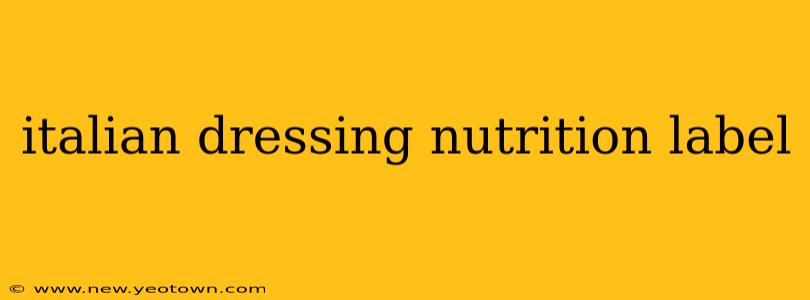Let's be honest, a vibrant, tangy Italian dressing can transform a simple salad from blah to breathtaking. But before you drizzle liberally, it's wise to understand what's actually in that bottle. This isn't just about calories; we're diving deep into the nutritional landscape of Italian dressing, exploring the variations, potential health impacts, and answering your burning questions. Imagine this as your personal nutrition guide for this beloved condiment.
What are the typical ingredients in Italian dressing?
The core components typically include oil (often olive oil, but sometimes other vegetable oils), vinegar (usually red wine vinegar, adding that characteristic tang), herbs (like oregano, basil, and parsley), and spices (garlic powder, onion powder, black pepper, and sometimes red pepper flakes for a kick). Many commercial versions also contain added sugar, salt, and preservatives to enhance shelf life and flavor. However, homemade Italian dressing offers much more control over these additions.
How many calories are in Italian dressing?
The calorie count varies dramatically depending on the brand and serving size. A typical 2-tablespoon serving can range from 100 to 150 calories, with the higher end often linked to added sugar and thicker, creamier versions. It's crucial to always check the nutrition label on the specific bottle you're using. Remember, those calories quickly add up, especially if you're using more than a couple of tablespoons on your salad.
What are the macros (carbs, fats, protein) in Italian dressing?
Italian dressing is primarily fat and carbohydrates. The fat content comes from the oil, contributing to the creamy texture and richness. Carbohydrates are usually introduced through added sugars, although the amount varies widely between brands. Protein content is minimal, typically negligible. Again, consulting the nutrition label for your specific brand is essential for accurate macro information.
Is Italian dressing healthy?
This is a nuanced question. In moderation, Italian dressing can be part of a healthy diet, especially if you opt for a low-sugar, oil-based version. The healthy fats in olive oil can offer benefits, and the herbs and spices contribute antioxidants and flavor. However, many commercial dressings are loaded with added sugar, salt, and preservatives, which can negate any potential health benefits. Therefore, moderation and ingredient awareness are key.
What are the nutritional differences between store-bought and homemade Italian dressing?
The biggest difference lies in control. Homemade Italian dressing lets you dictate the ingredients. You can select high-quality olive oil, control the sugar and salt content, and avoid potentially unhealthy additives. Store-bought options often prioritize shelf life and taste over strict nutritional profiles, often containing more additives.
How can I make healthier choices when it comes to Italian dressing?
Making healthier choices is surprisingly simple. First, read those labels! Look for dressings with lower sugar and sodium content, and prioritize those with olive oil as the primary fat source. Consider making your own dressing; it's easier than you might think and offers complete control over ingredients. Or, explore lighter options, such as vinaigrettes, which are generally lower in calories and fat.
Ultimately, understanding the nutrition label of your Italian dressing and making conscious choices empowers you to enjoy this flavorful condiment as part of a balanced and healthy diet. Remember, balance is key – enjoy your food, but also be mindful of what you're consuming.

